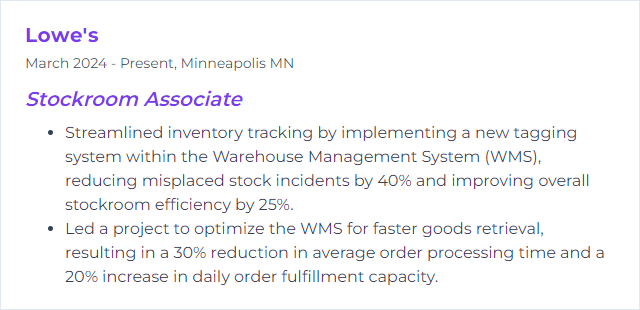Top 12 Stockroom Associate Skills to Put on Your Resume
In today's job market, a stockroom associate who stands out shows more than muscle and hustle. You blend precision with pace. You prove you can keep inventory tight, move product safely, and keep the whole operation humming. Put skills on your resume that signal reliability, speed, and clean execution—employers notice.
Stockroom Associate Skills
- Inventory Management
- Forklift Operation
- RFID Technology
- Barcode Scanning
- SAP Software
- Oracle Inventory
- Microsoft Excel
- Quality Control
- Shipping & Receiving
- Pallet Jack
- Cycle Counting
- WMS (Warehouse Management System)
1. Inventory Management
Inventory management means tracking, organizing, and controlling stock levels and movements so supply meets demand, waste stays low, and records stay accurate.
Why It's Important
It keeps stock right-sized, storage tidy, restocking timely, and data trustworthy. That translates into fewer surprises, faster fulfillment, and better service.
How to Improve Inventory Management Skills
Make it sharper, cleaner, faster.
Use an inventory system: Automate tracking, set reorder points, and flag variances in real time.
Audit often: Cycle count routinely so records mirror reality.
Run FIFO: First-In, First-Out keeps aging stock moving and waste down.
Organize relentlessly: Clear labels, logical zones, and tidy bays speed every task.
Train the team: Shared standards reduce errors and confusion.
Scan everything: Barcodes or RFID cut manual entry and boost accuracy.
Forecast with data: Review trends, seasonality, and lead times; adjust safety stock proactively.
These habits build a stockroom that runs smooth, not squeaky.
How to Display Inventory Management Skills on Your Resume
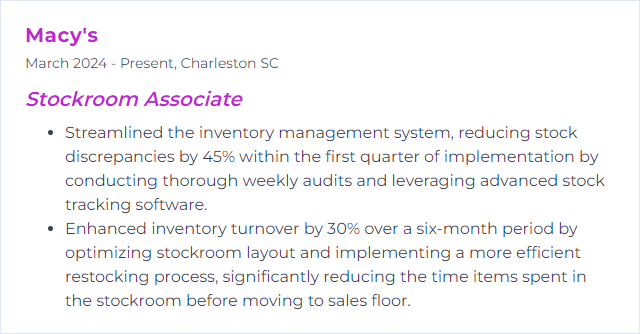
2. Forklift Operation
Operating a forklift means moving heavy loads quickly and safely—stacking, staging, and feeding lines without denting product or endangering people.
Why It's Important
It unlocks speed, space, and safety. Heavy lifts get done, aisles stay clear, and inventory flows where it should.
How to Improve Forklift Operation Skills
Safety first, then finesse.
Get certified and refresh: Train, practice, and re-evaluate regularly. Standards evolve; skills fade if ignored.
Inspect before use: Brakes, forks, hydraulics, tires, horn, lights—catch issues early.
Follow strict protocols: Respect load limits, speed rules, and pedestrian right-of-way. Never gamble with blind corners.
Design better pathways: Wide aisles, clear sightlines, well-marked zones reduce tight turns and near misses.
Maintain on schedule: Planned service beats breakdowns every time.
Leverage tech: Use scanners, location systems, and safety sensors where available.
Skill grows with habits. Consistency makes it second nature.
How to Display Forklift Operation Skills on Your Resume
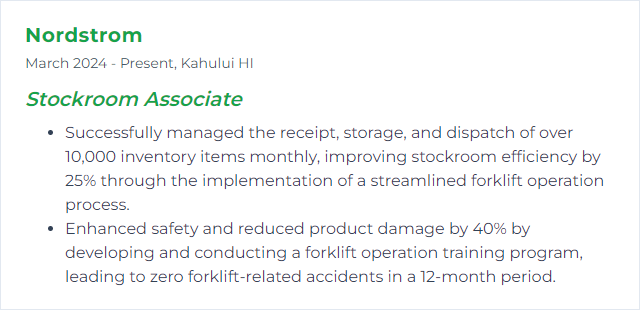
3. RFID Technology
RFID uses radio signals to identify and track tagged items automatically. No line-of-sight. Fast scans of entire pallets. Real-time visibility of what’s where.
Why It's Important
It slashes manual counting, reduces shrink and mispicks, and tightens accuracy across the stockroom.
How to Improve RFID Technology Skills
Dial in the hardware, the setup, and the habits.
Boost read rates: Tune antennas, reader placement, and tag orientation to cut missed reads.
Pick rugged tags: Choose materials that handle moisture, abrasion, and temperature swings.
Integrate cleanly: Sync RFID events to your inventory system so movements update instantly.
Manage interference: Select frequency ranges and power levels that behave well in your space.
Coordinate readers: Avoid reader collisions; schedule reads or use anti-collision logic.
Protect data: Use authentication and encryption where needed; lock tags when appropriate.
Train on placement and technique: Tag consistently; scan with intent; verify exceptions.
Better setup, better reads, better results.
How to Display RFID Technology Skills on Your Resume
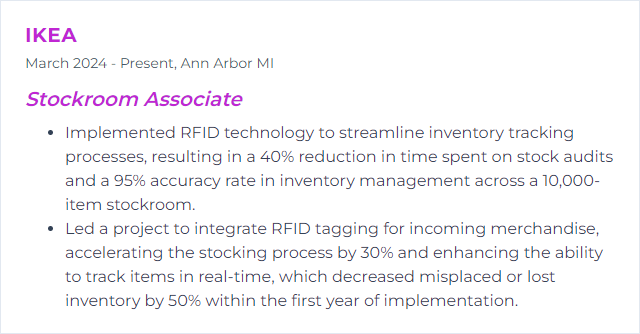
4. Barcode Scanning
Barcode scanning captures item data instantly—arrivals, picks, moves, counts—so records stay aligned with reality.
Why It's Important
It speeds workflows, kills data entry errors, and helps you find the right item the first time.
How to Improve Barcode Scanning Skills
Make scans effortless.
Light it well: Good lighting means quick, clean reads.
Use capable scanners: Choose models that handle damaged labels, long range, or dense codes as needed. Brands like Zebra and Honeywell offer robust options.
Keep lenses clean: Dust and smudges slow everything down.
Print durable labels: High contrast, proper sizing, thermal printing for longevity.
Coach technique: Comfortable grip, proper angle, steady aim; reduce strain and misreads.
Standardize placement: Put barcodes where hands naturally go; avoid seams and curves.
Update software: Support multiple symbologies and keep performance features current.
Small tweaks shave seconds off every scan. Those seconds compound.
How to Display Barcode Scanning Skills on Your Resume
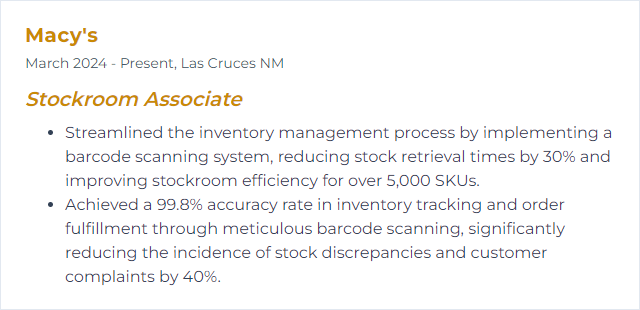
5. SAP Software
SAP is an ERP platform that ties inventory, orders, and reporting together so stockroom work connects cleanly to the rest of the business.
Why It's Important
It improves stock accuracy, speeds order handling, and gives visibility across teams, which reduces rework and delays.
How to Improve SAP Software Skills
Make SAP work for the floor, not against it.
Train for the tasks: Teach the exact transactions and screens a stockroom needs, not generic walkthroughs.
Simplify with Fiori: Use role-based, streamlined apps that cut clicks and confusion.
Go mobile: Enable handheld workflows for counts, picks, and receipts in real time.
Automate repeats: Post goods movements, trigger replenishment, and schedule counts automatically where sensible.
Use analytics: Monitor turns, aging stock, and exceptions; act on what the numbers whisper.
Collect feedback: Iterate forms and flows based on user pain points.
How to Display SAP Software Skills on Your Resume
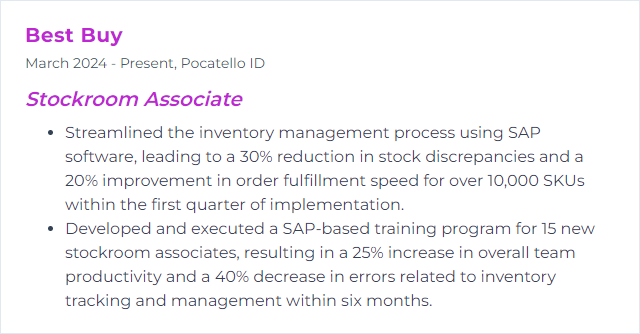
6. Oracle Inventory
Oracle Inventory manages on-hand quantities, receipts, issues, and replenishment—central control for what’s in, out, and due.
Why It's Important
It tightens accuracy, speeds fulfillment, and links stockroom moves to purchasing, manufacturing, and finance.
How to Improve Oracle Inventory Skills
Turn features into daily wins.
Clean data relentlessly: Standardize item masters, units, and locations; audit often.
Scan everything: Reduce manual entry with barcode transactions and label printing.
Use mobile apps: Transact receipts, issues, and transfers right where the work happens.
Schedule cycle counts: Frequent, focused counts beat painful year-end scrambles.
Tune replenishment: Safety stock, min/max, lead times—calibrate so stock arrives just in time, not just in case.
Train continuously: New hires and veterans both benefit from refreshers and tips.
Leverage reports: Track variances, backorders, and slow movers; kill root causes.
Better setup and discipline make the system sing.
How to Display Oracle Inventory Skills on Your Resume
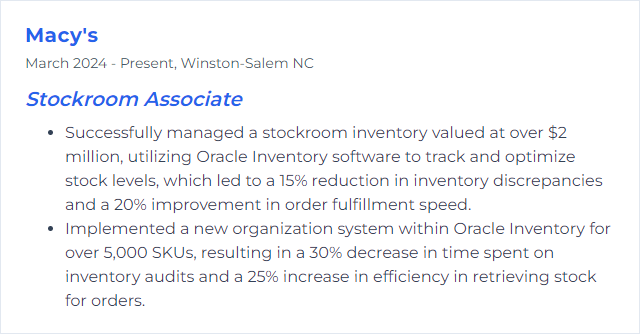
7. Microsoft Excel
Excel is a spreadsheet workhorse for tracking counts, reconciling discrepancies, analyzing trends, and building simple dashboards.
Why It's Important
It helps you spot stock risks, prepare reports, and model what-if scenarios without waiting on a systems team.
How to Improve Microsoft Excel Skills
Practical skills that pay off on the floor.
Master core functions: SUM, IF, COUNTIF, VLOOKUP or INDEX/MATCH, and basic date math for lead times and turns.
Use PivotTables: Summarize large datasets fast; drill into exceptions.
Visualize clearly: Charts for stock aging, fill rates, and variance trends—simple and readable.
Start with templates: Build inventory logs, receiving sheets, and count forms you can refresh daily.
Automate with macros: Record repetitive steps and button them up.
Good spreadsheets make better decisions obvious.
How to Display Microsoft Excel Skills on Your Resume
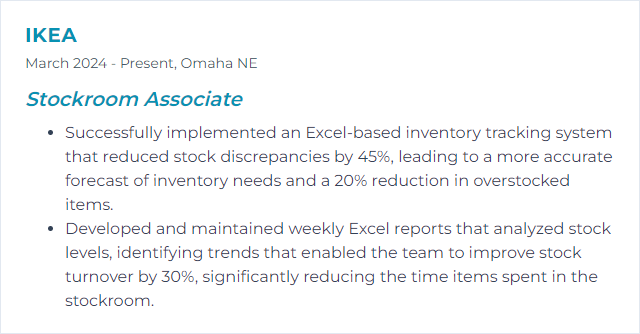
8. Quality Control
Quality Control means verifying item condition, quantity, and specs at every handoff—receiving, storage, picks, and shipments.
Why It's Important
It prevents returns, protects brand reputation, and saves time you’d otherwise waste fixing avoidable mistakes.
How to Improve Quality Control Skills
Build rigor into routine.
Standardize SOPs: Clear steps, acceptance criteria, and escalation paths for each task.
Digitize checks: Use checklists and scans to document inspections and trace defects.
Train and re-train: Calibrate the team on what “good” looks like; run quick refreshers.
Audit regularly: Spot patterns, not just one-off misses; fix the process, not only the error.
Close the loop: Capture feedback from picking, packing, and customers; feed it into standards.
Lean thinking: Remove steps that don’t add value; reduce handoffs that introduce risk.
Consistency beats heroics every time.
How to Display Quality Control Skills on Your Resume

9. Shipping & Receiving
Shipping & Receiving covers the intake and outflow of goods—verifying paperwork, inspecting items, labeling, staging, and recording every movement.
Why It's Important
It’s the heartbeat of fulfillment. Accurate receipts prevent shortages; precise shipments prevent returns.
How to Improve Shipping & Receiving Skills
Speed paired with precision.
Run a live inventory system: Record receipts and shipments immediately; no end-of-day surprises.
Lock in SOPs: Standard pack lists, labeling rules, damage handling, and carrier handoff steps.
Scan at every touch: Item, location, lot—trace it all.
Organize the dock: Clear lanes, labeled staging, and time windows reduce chaos.
Coach continuously: Refresh on packaging, hazmat flags, weight limits, and documentation.
Review metrics: Track dock-to-stock time, mis-ships, and damages—then fix the biggest offenders.
When the dock flows, the warehouse breathes easier.
How to Display Shipping & Receiving Skills on Your Resume
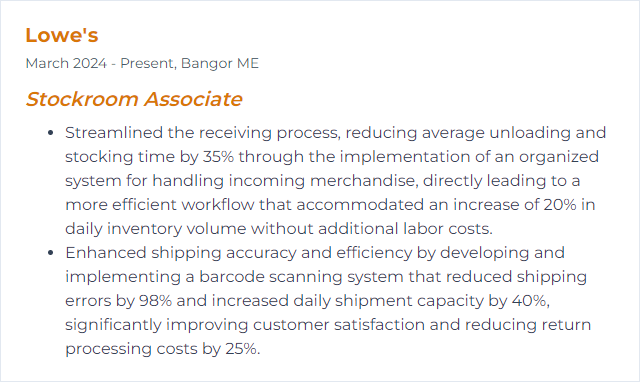
10. Pallet Jack
A pallet jack—manual or powered—moves palletized loads through tight spaces and short runs without the overhead of a forklift.
Why It's Important
It’s the quick mover. Safe, simple, and efficient for frequent repositioning.
How to Improve Pallet Jack Skills
Protect your back, your load, and your time.
Train on the model you use: Know capacity, controls, and stopping distances.
Inspect routinely: Wheels, forks, hydraulics—fix small issues before they grow teeth.
Push, don’t pull: Better ergonomics; better control.
Clear the path: No surprises around corners or clutter in aisles.
Wear the right gear: Gloves for grip, safety shoes for protection.
Load evenly: Center the weight; keep the load stable and low.
Scale up when needed: For heavier, longer hauls, consider powered options.
Smart technique turns a simple tool into a productivity booster.
How to Display Pallet Jack Skills on Your Resume
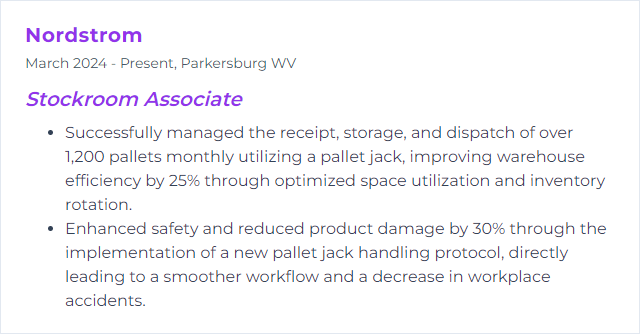
11. Cycle Counting
Cycle counting checks slices of inventory on a schedule so accuracy stays high without shutting everything down for a full physical count.
Why It's Important
It catches errors early, keeps numbers honest, and supports dependable fulfillment.
How to Improve Cycle Counting Skills
Accuracy without drama.
Prioritize by impact: High-value, fast movers, and problem-prone items get counted more often.
Use scanners or RFID: Faster counts, fewer fat-finger mistakes.
Train on procedure: Location verification, recount rules, and exception handling need to be crystal clear.
Schedule smart: Spread counts to avoid bottlenecks; don’t stall operations.
Analyze discrepancies: Find root causes—receiving errors, mislabels, pick mistakes—and fix upstream.
Adjust as you learn: Tune frequencies and item lists based on results.
Frequent light touches beat heavy, infrequent cleanups.
How to Display Cycle Counting Skills on Your Resume

12. WMS (Warehouse Management System)
A WMS orchestrates warehouse work—receiving, putaway, slotting, picking, replenishment, and shipping—so people and product move with purpose.
Why It's Important
It lifts accuracy, compresses lead times, and makes better use of space and labor.
How to Improve WMS (Warehouse Management System) Skills
Turn features into flow.
Pair with RFID or scanning: Real-time movements, fewer missed steps.
Mobilize the floor: Handhelds or wearables for instant, on-the-spot updates.
Optimize slotting and paths: Place fast movers close; reduce travel with smart pick routes.
Train and iterate: Teach functions that matter; collect feedback and refine.
Run lean: Right-size stock levels; cap open work; kill wasteful touches.
Automate where it counts: Conveyors, put-to-light, or AS/RS when volume and profile justify it.
Use data: Forecast demand, set labor plans, and watch KPIs like pick rate and order accuracy.
Maintain and update: Patch, upgrade, and test regularly to keep performance tight and secure.
A tuned WMS turns chaos into choreography.
How to Display WMS (Warehouse Management System) Skills on Your Resume
